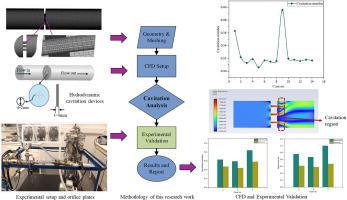Numerical modelling and experimental validation of an orifice plate-based hydrodynamic cavitation process for improving the biomass pretreatment
Q1 Immunology and Microbiology
引用次数: 0
Abstract
Hydrodynamic cavitation can be used to pretreat biomass by utilizing the energy released during the collapse of cavitation bubbles. Delignification as pretreatment enhances the biodegradation of lignocellulosic composition. The present study employed a CFD model and experimental validation of the numerical analysis of hydrodynamic cavitation (HC) in multi-hole orifice (MHO) designs under various operating conditions. The total 14 geometry of the orifice plate depends on the plate thickness, the number of holes, and the hole orientation used to analyze and optimize geometry for the biomass pretreatment process. Three phases are used in numerical analysis and experimentation to investigate the effect of particles on cavitation. The simulated results regarding velocity and pressure gradients, turbulence quantities, and vapor volume fractions are critically analyzed and discussed. The cavitation number changes to 0.22 in the experiment and 0.16 in the simulation due to the presence of biomass particles. Orifice plate thickness was found to significantly influence cavitation inception and evolution. 4 mm thickness and nine holes with specific orientations were found to be an optimized geometry with the lowest cavitation number, maximum pressure drop, and highest throat velocity. In the experimentation, 0.8 mm biomass particles were used in the mixture (2 % w/w) to determine the effect of biomass particles on the flow. This result helps identify the critical operating and design parameters and the impact on the cavitation of particles to achieve the desired cavitation phenomena.

基于孔板的水力空化工艺改进生物质预处理的数值模拟与实验验证
水动力空化可以利用空化气泡破裂时释放的能量对生物质进行预处理。脱木质素预处理提高了木质纤维素成分的生物降解。本文采用CFD模型和实验验证方法,对不同工况下多孔口设计中的水动力空化现象进行了数值分析。孔板的总几何形状取决于板的厚度、孔的数量以及用于分析和优化生物质预处理过程的孔的方向。采用三相数值分析和实验方法研究了颗粒对空化的影响。对速度和压力梯度、湍流量和蒸汽体积分数的模拟结果进行了严格的分析和讨论。由于生物质颗粒的存在,实验空化数为0.22,模拟空化数为0.16。孔板厚度对空化的产生和演化有显著影响。结果表明,厚度为4mm、孔径为9个定向孔的优化几何形状具有最小的空化数、最大的压降和最高的喉道速度。实验中,在混合物中加入0.8 mm的生物质颗粒(2% w/w),以确定生物质颗粒对流动的影响。该结果有助于确定关键的操作和设计参数以及对颗粒空化的影响,以实现所需的空化现象。
本文章由计算机程序翻译,如有差异,请以英文原文为准。
求助全文
约1分钟内获得全文
求助全文
来源期刊

Biotechnology Reports
Immunology and Microbiology-Applied Microbiology and Biotechnology
CiteScore
15.80
自引率
0.00%
发文量
79
审稿时长
55 days
期刊介绍:
Biotechnology Reports covers all aspects of Biotechnology particularly those reports that are useful and informative and that will be of value to other researchers in related fields. Biotechnology Reports loves ground breaking science, but will also accept good science that can be of use to the biotechnology community. The journal maintains a high quality peer review where submissions are considered on the basis of scientific validity and technical quality. Acceptable paper types are research articles (short or full communications), methods, mini-reviews, and commentaries in the following areas: Healthcare and pharmaceutical biotechnology Agricultural and food biotechnology Environmental biotechnology Molecular biology, cell and tissue engineering and synthetic biology Industrial biotechnology, biofuels and bioenergy Nanobiotechnology Bioinformatics & systems biology New processes and products in biotechnology, bioprocess engineering.
 求助内容:
求助内容: 应助结果提醒方式:
应助结果提醒方式:


